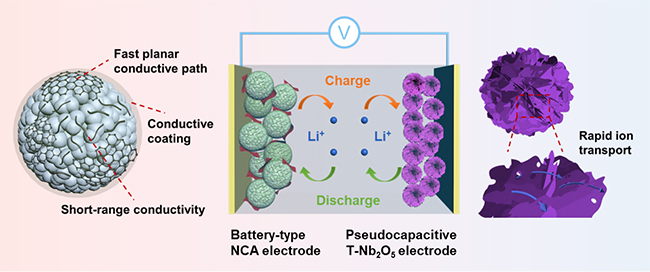Battery-supercapacitor hybrid devices (BSHDs), which combine battery-type and capacitor-type electrodes in one cell, can fulfill the dual demands for high energy and power densities.
However, the performance of current BSHDs is restricted by the electrolyte-consuming mechanism and imbalance of charge-storage capacity and electrode kinetics between the two types of electrodes.
Recently, a research team led by Prof. WU Zhong-Shuai from the Dalian Institute of Chemical Physics of the Chinese Academy of Sciences developed new BSHDs based on two matched faradaic electrodes with a rocking-chair mechanism analogous to lithium-ion batteries.
This study was published online in Energy & Environmental Science on March 17.

Schematic illustration of the charge storage mechanisms for rocking-chair T-Nb2O5-NF//NCA-3D BSHD (Image by SU Feng)
The scientists developed these new BSHDs with a rocking-chair mechanism analogous to lithium-ion batteries by employing an intercalation pseudocapacitive T-Nb2O5 anode and a battery-type nickel-rich layered oxide (LiNi0.815Co0.15Al0.035O2) cathode with comparable faradaic capacities.
For electrode kinetics matching, they constructed a porous nanoflower structure and a three-dimensional interconnected conductive network formed by one-dimensional carbon nanotubes, two-dimensional electrochemically exfoliated graphene sheets, and conductive polymer binder for the anode and cathode, respectively. This facilitated BSHDs' charge transfer processes.
By virtue of doubly matched capacities and kinetics, the assembled BSHDs achieved superior performance to previously reported rocking-chair BSHDs and other counterparts with unmatched electrodes.
"This work could inspire cell configuration design and electrode structure optimization for high-energy and high-power electrochemical energy storage," said Prof. WU.
The above work was supported by National Natural Science Foundation of China, National Key R&D Program of China, Dalian National Laboratory for Clean Energy, CAS, etc. (Text by SU Feng and HOU Xiaocheng)